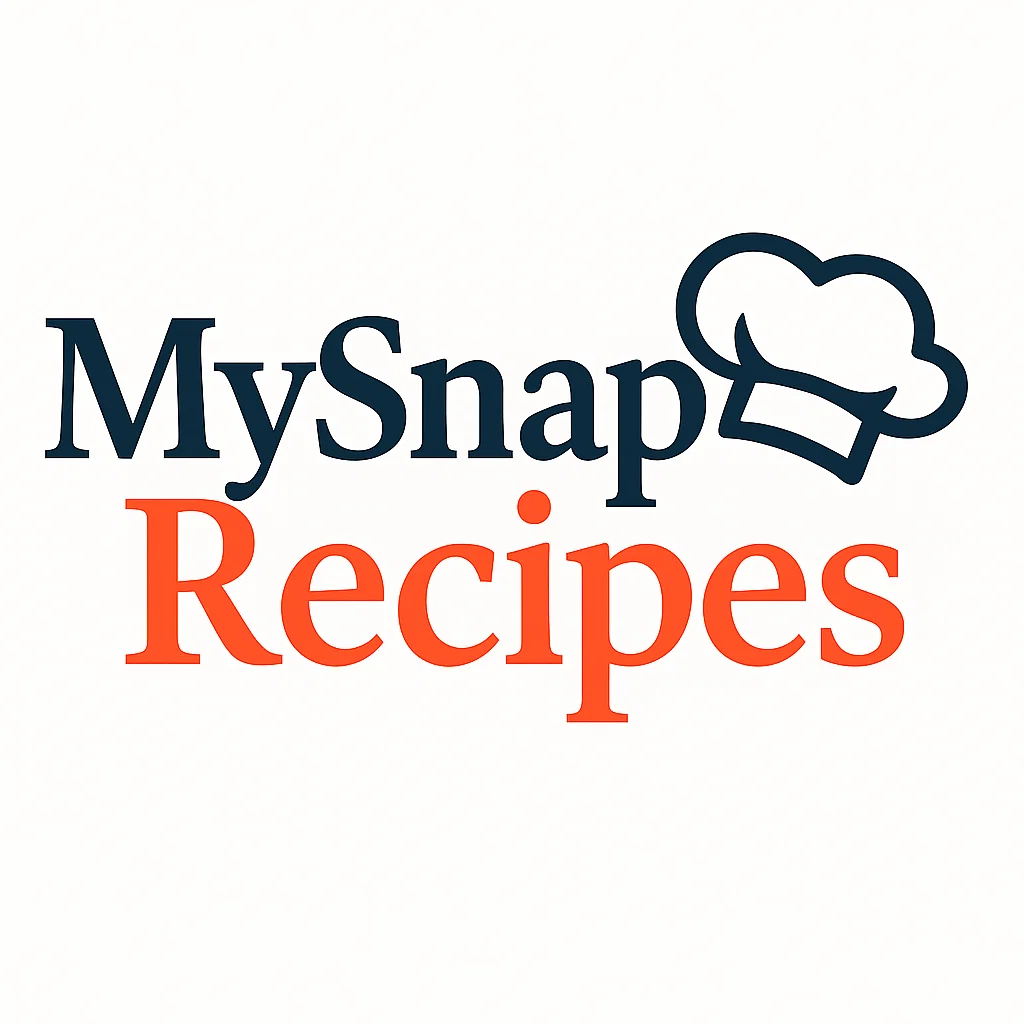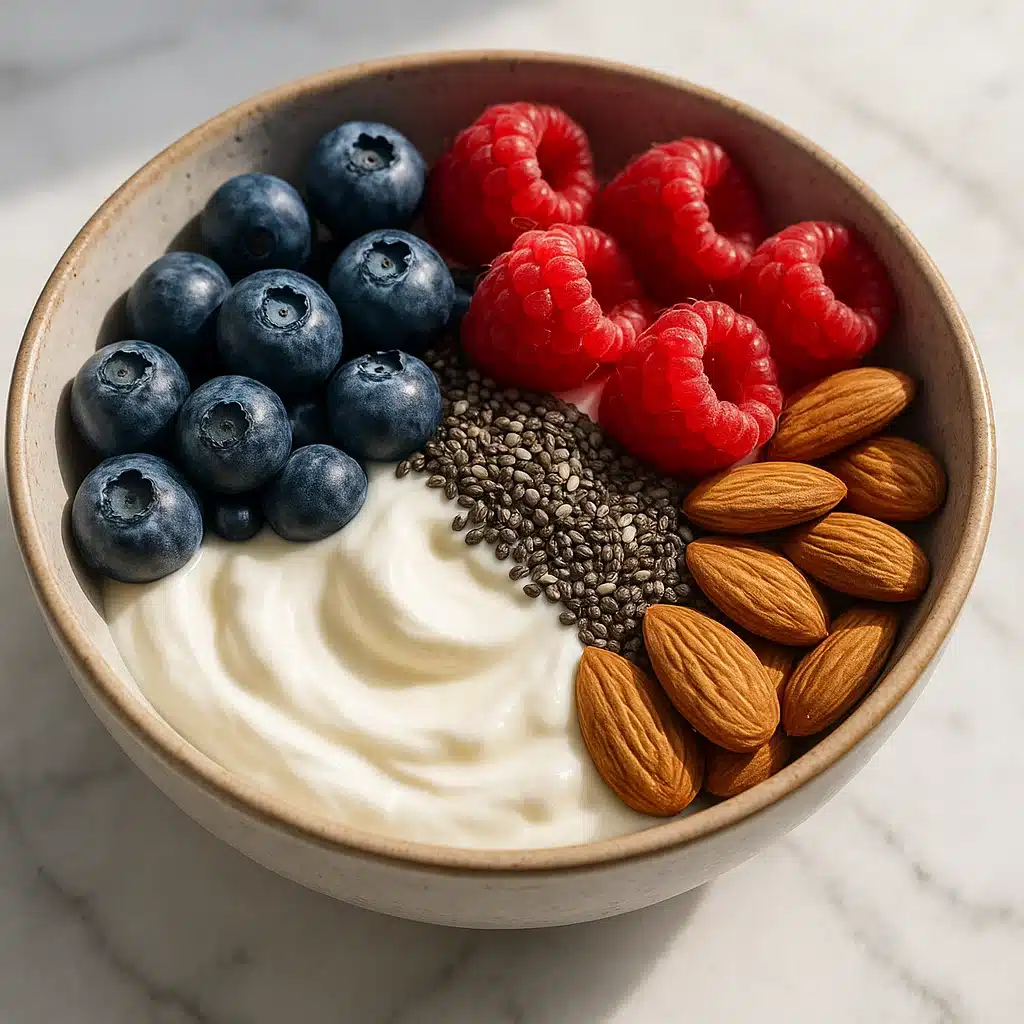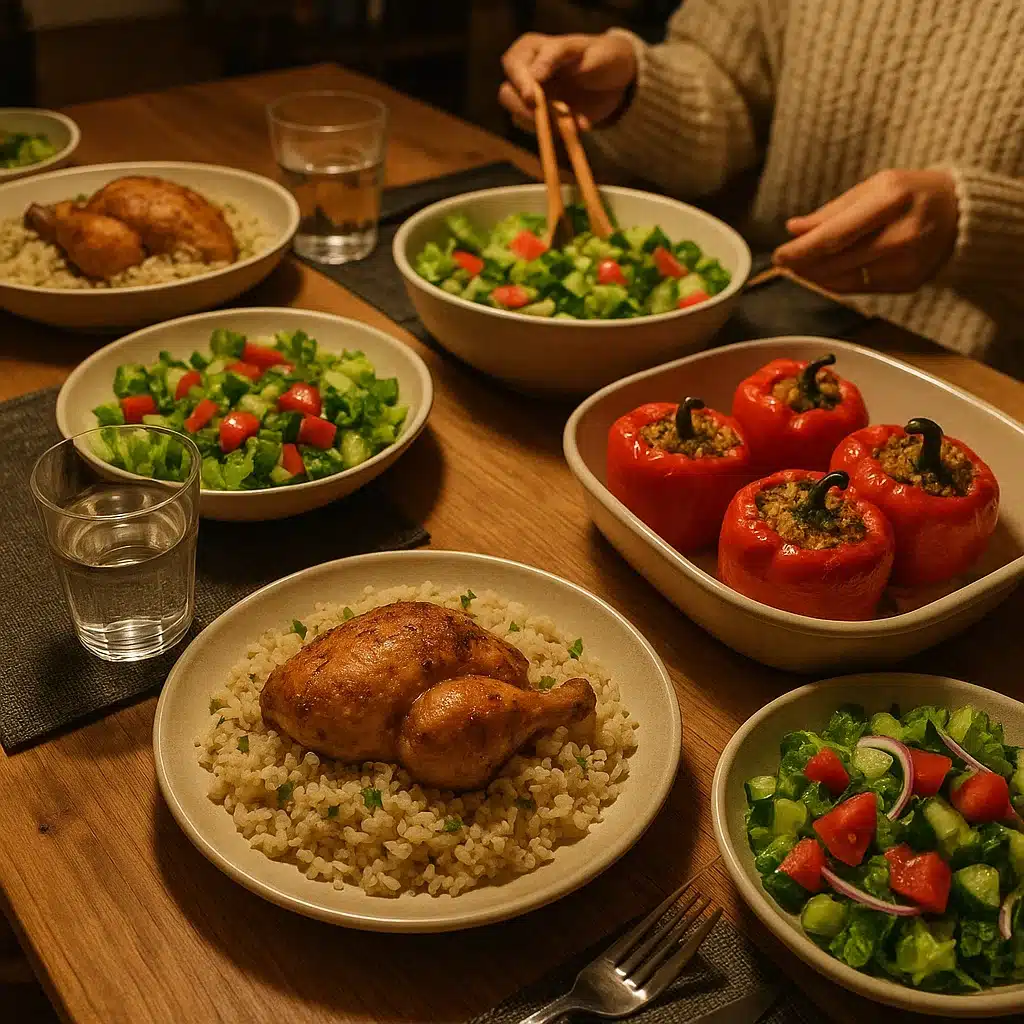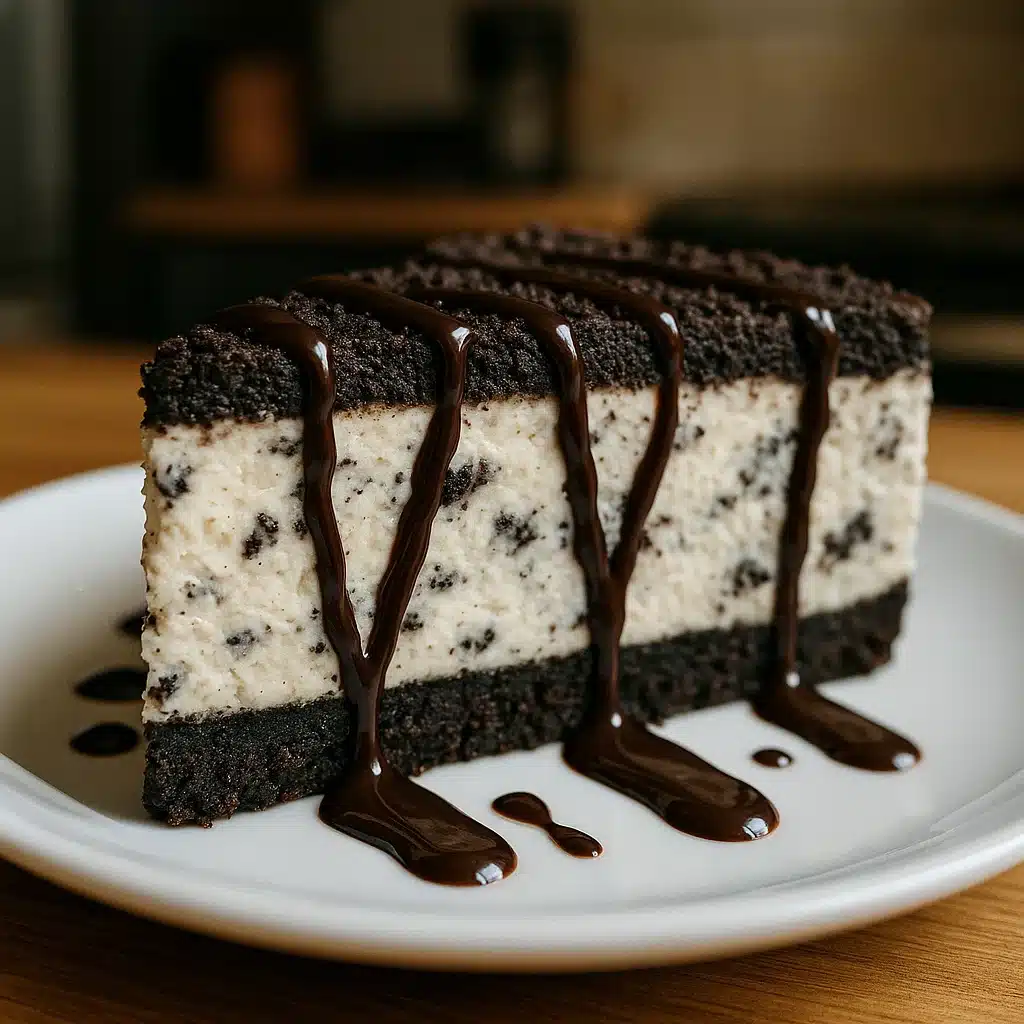Looking for a healthy, quick, and satisfying lunch idea? These Tuna White Bean Salad Wraps check all the boxes. With simple pantry staples like canned tuna, creamy cannellini beans, heart-healthy olive oil, and crunchy lettuce leaves, this recipe is nutritious, high in protein, and ready in minutes.
Whether you’re meal-prepping for the week or need a fast, no-cook dinner, these wraps deliver flavor without the fuss—or the calories. Plus, they’re naturally low in carbs and gluten-free when wrapped in lettuce, making them ideal for clean eating or weight loss plans.
Craving more wrap options? Check out our Chickpea Salad Wrap Recipe for another protein-packed plant-based alternative.
Print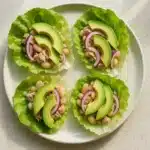
Tuna White Bean Salad Wraps – Easy, Healthy, and Protein-Packed Meal Prep
- Prep Time: 10 minutes
- Cook Time: 0 minutes
- Total Time: 10 minutes
- Yield: 12 1x
- Category: Lunch / Light Dinner
- Cuisine: Mediterranean-Inspired
- Diet: Gluten Free
Description
These Tuna White Bean Salad Wraps are a light, protein-packed meal perfect for clean eating, weight loss, or quick lunches. Made with flaky tuna, creamy white beans, red onion, and avocado, all wrapped in crisp lettuce leaves, this no-cook recipe is gluten-free, low-carb, and bursting with fresh Mediterranean flavor. Ideal for meal prep and ready in just 10 minutes!
Ingredients
1 can (12 oz) light tuna in water, drained and flaked
1 can (15 oz) cannellini beans, rinsed and drained
¼ cup chopped red onion
2 tablespoons olive oil
1 tablespoon minced fresh parsley
⅛ teaspoon salt
⅛ teaspoon black pepper
12 Bibb or Boston lettuce leaves (about 1 medium head)
1 medium ripe avocado, peeled and sliced
Instructions
-
In a medium mixing bowl, combine tuna, beans, red onion, olive oil, parsley, salt, and pepper.
-
Gently toss to mix, keeping texture slightly chunky.
-
Rinse and pat dry the lettuce leaves.
-
Spoon 2–3 tablespoons of the tuna-bean mixture into each leaf.
-
Top with avocado slices.
-
Serve immediately or store filling and lettuce separately for later.
Notes
Add lemon juice or zest for a fresh twist.
Substitute avocado with hummus or Greek yogurt for different flavor profiles.
For meal prep, store filling in the fridge up to 3–4 days and assemble just before serving.Swap lettuce with whole wheat wraps for a more filling version.
Nutrition
- Serving Size: 4
- Calories: 279
- Sugar: 1g
- Sodium: 421mg
- Fat: 13g
- Carbohydrates: 19g
- Fiber: 7g
- Protein: 22g
- Cholesterol: 31mg
Table of Contents
Table of Contents
Why Tuna White Bean Salad Wraps Are the Perfect Meal Solution
The Balance of Flavor, Nutrition, and Convenience
In a world where quick meals often mean processed foods or drive-thru stops, Tuna White Bean Salad Wraps are a refreshing solution. They’re:
- Ready in under 15 minutes
- Rich in protein and fiber
- Portable and meal-prep friendly
- Loaded with healthy fats and complex carbs
- Naturally gluten-free and low in sugar
The mild creaminess of cannellini beans pairs beautifully with lean tuna, and when wrapped in crisp Bibb or Boston lettuce, you get the satisfying bite of a sandwich—without the heavy bread or extra calories.
Plus, this recipe can be customized to your family’s tastes. Add fresh herbs, avocado, a squeeze of lemon, or even swap in another type of bean or protein. The base is flexible, delicious, and surprisingly filling.
What Makes This Wrap an Ideal Option for Healthy Lifestyles
This recipe is more than just convenient—it fits seamlessly into a variety of healthy eating goals:
- For weight loss: It’s high in protein and fiber, which keeps you full longer.
- For heart health: Tuna provides omega-3s, olive oil offers monounsaturated fats, and beans help lower cholesterol.
- For diabetic-friendly meals: With only 19g of carbs and 7g of fiber per serving, these wraps have a low glycemic impact.
- For gluten-free diets: Lettuce wraps are naturally free from gluten and grains.
Want even more veggie-packed, healthy wrap ideas? Try the Veggie and Hummus Wrap—another reader favorite.
Ingredients Spotlight – What Makes This Tuna White Bean Salad Wraps Recipe Work
Nutritional Benefits of Tuna, White Beans, and Avocado
What makes Tuna White Bean Salad Wraps one of the most balanced, nutritious meals you can prep in minutes? It’s all in the ingredients. These wraps bring together lean protein, heart-healthy fats, and fiber-rich carbs into a meal that supports weight loss, digestion, and sustained energy—all without compromising on flavor.
1. Light Tuna in Water
As the base of these Tuna White Bean Salad Wraps, tuna offers a high-quality protein source that’s low in calories but rich in omega-3 fatty acids. It helps support brain function, heart health, and muscle repair—making it a go-to for anyone focused on clean eating.
2. Cannellini Beans (White Kidney Beans)
The “white bean” in these Tuna White Bean Salad Wraps provides creamy texture, plant-based protein, and slow-digesting carbs. Beans are full of fiber and help keep you full longer, which is ideal if you’re trying to stay satisfied between meals.
3. Avocado
Each wrap gets topped with fresh avocado slices, delivering healthy fats and a smooth texture that balances out the protein and beans perfectly. Avocado also adds fiber and a dose of potassium—key for staying energized throughout the day.
4. Olive Oil, Red Onion, and Fresh Parsley
The dressing in these Tuna White Bean Salad Wraps is simple but powerful. A drizzle of extra virgin olive oil binds the salad, while red onion and parsley brighten up the flavor profile without overpowering it.
Why Lettuce Makes the Perfect Low-Carb Wrap
Rather than using tortillas or bread, Tuna White Bean Salad Wraps are built inside crisp Bibb or Boston lettuce leaves. This swap cuts the carbs, lowers the calories, and adds a refreshing crunch with every bite.
Lettuce also:
- Makes these wraps naturally gluten-free
- Supports hydration and digestion
- Keeps the recipe light, clean, and ideal for weight-conscious eating
If you’re meal prepping, simply store the salad mixture separately and assemble your Tuna White Bean Salad Wraps just before serving for the best texture.
Want another wrap idea that’s equally healthy and portable? Try our Veggie and Hummus Wrap—it’s another great addition to your clean-eating routine.
How to Make Tuna White Bean Salad Wraps (Step-by-Step)
Making Tuna White Bean Salad Wraps is surprisingly quick and easy. With just a few pantry staples and fresh ingredients, you’ll have a nutritious meal on the table—or packed for lunch—in less than 15 minutes.
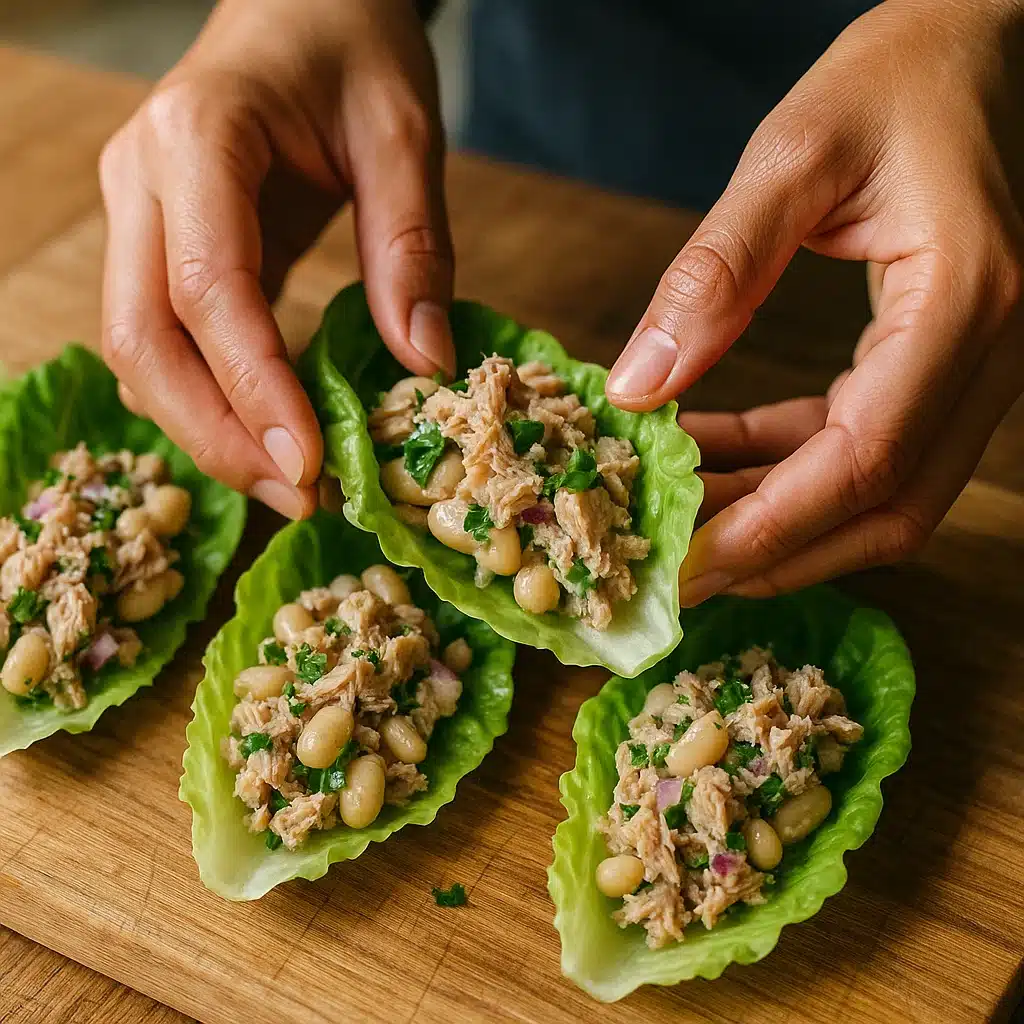
Ingredients You’ll Need
- 1 can (12 oz) light tuna in water, drained and flaked
- 1 can (15 oz) cannellini beans, rinsed and drained
- ¼ cup chopped red onion
- 2 tablespoons olive oil
- 1 tablespoon minced fresh parsley
- ⅛ teaspoon salt
- ⅛ teaspoon pepper
- 12 Bibb or Boston lettuce leaves (about 1 medium head)
- 1 medium ripe avocado, peeled and sliced
This simple lineup keeps the Tuna White Bean Salad Wraps clean, filling, and full of flavor.
Step-by-Step Instructions
Step 1: Make the Salad Filling
In a medium bowl, combine the tuna, beans, red onion, olive oil, parsley, salt, and pepper. Gently toss until the ingredients are well-mixed but not mashed.
Step 2: Prep the Lettuce Wraps
Wash and pat dry the lettuce leaves. Select whole, unbroken leaves large enough to hold the filling like a taco shell.
Step 3: Assemble the Wraps
Scoop a generous spoonful of the tuna-bean mixture into each lettuce leaf. Top with sliced avocado for creaminess.
Step 4: Serve or Pack
Eat immediately or refrigerate the filling separately and assemble later for a quick grab-and-go lunch.
Pro Tips for the Best Tuna White Bean Salad Wraps
- Mash some of the beans lightly to make the mixture creamier and help it hold together in the wrap.
- Add lemon juice for a zesty flavor boost and a splash of brightness.
- Chill the mixture for 30 minutes if you want the flavors to meld before serving.
- Use a mix of greens if Bibb lettuce isn’t available—Romaine or iceberg works too.
These Tuna White Bean Salad Wraps are not only easy to assemble, but they’re also perfect for meal prep. Make a batch at the start of the week and enjoy high-protein, satisfying meals all week long.
Creative Add-Ins and Swaps to Customize Your Tuna White Bean Salad Wraps
One of the best things about Tuna White Bean Salad Wraps is how versatile they are. You can enjoy them exactly as written—or make a few swaps and additions to keep things interesting throughout the week. Whether you want more crunch, heat, or extra nutrients, this recipe adapts beautifully.
Veggie Add-Ins to Boost Texture and Flavor
Want to upgrade your wraps with more vegetables? Try mixing in any of these fresh, crisp add-ins:
- Diced cucumber – Adds crunch and hydration
- Grated carrots – Slightly sweet and perfect for texture
- Shredded cabbage – Crunchy and colorful
- Diced bell peppers – Add sweetness and vitamin C
- Sliced radishes – For a peppery bite
- Chopped celery – Clean and crisp texture
These additions bulk up your Tuna White Bean Salad Wraps without adding many calories, making them even more filling and satisfying.
Flavor Boosters and Herbs to Try
Herbs and seasonings can instantly elevate the flavor profile. Consider adding:
- Fresh dill or basil
- Lemon zest or a splash of lemon juice
- Chopped green onions
- Cracked black pepper or a dash of smoked paprika
These ingredients keep your Tuna White Bean Salad Wraps fresh and vibrant—perfect for summer lunches or meal prep variety.
Swaps for More Variety
Mix things up with these healthy, diet-friendly ingredient swaps:
| Ingredient | Swap Suggestion |
|---|---|
| Cannellini beans | Chickpeas or black beans |
| Avocado | Hummus or tahini drizzle |
| Olive oil | Greek yogurt (for a creamier base) |
| Lettuce leaves | Whole wheat tortillas or collard green wraps |
| Tuna | Canned salmon or grilled chicken |
By making small changes, you can transform your Tuna White Bean Salad Wraps into something new each time—while still sticking to a healthy, protein-rich base.
Want more wrap inspiration? Check out our Spinach Feta Wrap Recipe for a warm, cheesy twist that’s perfect year-round.
Are Tuna Wraps Healthy? A Closer Look at the Nutrition
When it comes to quick, satisfying meals that support your wellness goals, Tuna White Bean Salad Wraps are hard to beat. But how do they actually stack up in terms of nutrition?
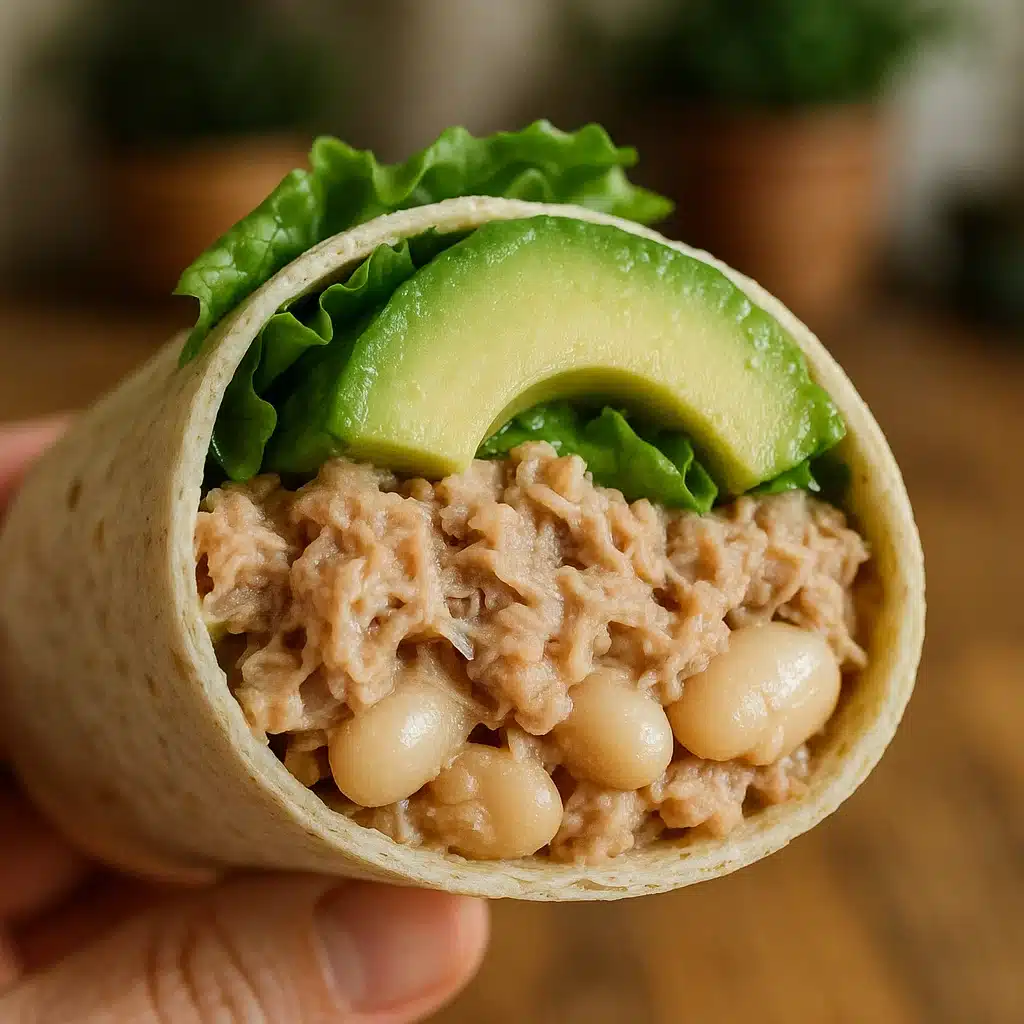
Let’s break down why these wraps are more than just tasty—they’re a smart, balanced choice for clean eating, weight loss, and heart health.
Calories and Macros Per Serving
Here’s the nutritional snapshot per 3 lettuce wraps (1 serving):
- Calories: 279
- Protein: 22g
- Fat: 13g (2g saturated)
- Carbs: 19g
- Fiber: 7g
- Sugar: 1g
- Cholesterol: 31mg
- Sodium: 421mg
With 22g of protein and just 19g of carbs, Tuna White Bean Salad Wraps provide the ideal balance for anyone focused on lean muscle, fat loss, or keeping blood sugar stable.
Why These Wraps Work for Weight Loss
If you’re watching your calories or trying to slim down, these wraps fit right in. Here’s why:
- High in protein – Promotes satiety and helps prevent overeating
- Rich in fiber – Slows digestion, supports gut health, and regulates appetite
- Low in refined carbs – Using lettuce instead of bread cuts down on empty calories
- Healthy fats from olive oil and avocado – Keeps you full and nourished
When combined, the tuna, white beans, and avocado in these wraps create a meal that’s nutritionally dense, satisfying, and diet-friendly.
Want more nutrient-dense wrap recipes? Explore the Chickpea Salad Wrap for another healthy, plant-based option.
Tuna and Beans – A Healthy Power Duo Explained
When it comes to clean, protein-rich meals, Tuna White Bean Salad Wraps stand out thanks to the unbeatable combination of lean fish and fiber-filled legumes. This pairing isn’t just convenient—it’s a nutrition powerhouse.
Why Tuna and White Beans Work So Well Together
Let’s look at the health benefits of combining these two simple ingredients:
| Nutrient | Tuna | White Beans (Cannellini) |
|---|---|---|
| Protein | 20g+ per can | 15g per cup |
| Omega-3 Fatty Acids | Heart health, anti-inflammatory | N/A |
| Fiber | Minimal | 11g per cup |
| Iron | Moderate | Excellent plant-based source |
| Potassium | Present | Helps regulate blood pressure |
Together, tuna and beans deliver complete nutrition: lean protein, healthy fat (when paired with avocado or olive oil), complex carbohydrates, and fiber—all in one delicious wrap.
Health Benefits Backed by Science
Here’s why this combo is worth including regularly in your meals:
- Supports muscle growth and repair thanks to high-quality protein
- Boosts digestion and gut health from fiber in beans
- Keeps you fuller longer, helping reduce between-meal snacking
- Promotes heart health with omega-3s and cholesterol-lowering fiber
- Stabilizes blood sugar, making it ideal for those managing diabetes
Plus, this tuna-and-bean combo is budget-friendly, easy to store, and incredibly versatile. It’s one of the many reasons Tuna White Bean Salad Wraps are becoming a staple in meal-prep routines across health-conscious households.
Looking for another balanced lunch idea? Try our Roasted Veggie Couscous Bowl—perfect for plant-based eaters seeking similar benefits.
What Sauce to Put in a Tuna Wrap? Flavor Without the Calories
One of the easiest ways to elevate your Tuna White Bean Salad Wraps is with the right sauce or dressing. While the base mixture is full of natural flavor thanks to olive oil, herbs, and red onion, adding a drizzle of sauce can bring in bold taste—without ruining the health benefits.
Here’s how to choose the perfect sauce for your wraps, without piling on extra calories or processed ingredients.
Best Light Sauces for Tuna Wraps
If you’re looking to add moisture, creaminess, or zing, try these healthy options:
- Lemon-Garlic Yogurt Sauce
Mix plain Greek yogurt with fresh lemon juice, garlic, salt, and a pinch of dill for a tangy finish. - Avocado Lime Cream
Blend avocado with lime juice, a bit of olive oil, and water until smooth for a creamy, dairy-free option. - Tahini Dressing
For a Mediterranean twist, mix tahini with lemon juice, garlic, and a touch of maple syrup for balance. - Honey Mustard Light Sauce
Combine Dijon mustard, a touch of honey, and a splash of vinegar for a sweet-and-savory drizzle.
These sauces pair perfectly with the tuna and white bean filling, keeping your Tuna White Bean Salad Wraps fresh and exciting.
Sauces to Avoid (and Healthy Alternatives)
| Skip This | Try Instead |
|---|---|
| Full-fat mayo | Avocado, Greek yogurt, or hummus |
| Creamy ranch | Yogurt-herb dressing |
| Store-bought aioli | Homemade garlic yogurt blend |
| High-sugar dressings | Mustard, vinaigrette, tahini sauce |
Keeping the sauce healthy ensures your wrap remains a lean and nutrient-dense option that fits into most eating plans.
Want another healthy recipe with creamy texture and zero guilt? Try our Spinach Feta Wrap Recipe—it uses simple ingredients and packs big flavor.
Pack It Up – Meal Prep and Lunchbox Tips
Tuna White Bean Salad Wraps are not just a quick fix for lunch—they’re also ideal for weekly meal prep, office lunches, and on-the-go meals. With the right packing method, you can enjoy these wraps fresh anytime, anywhere.
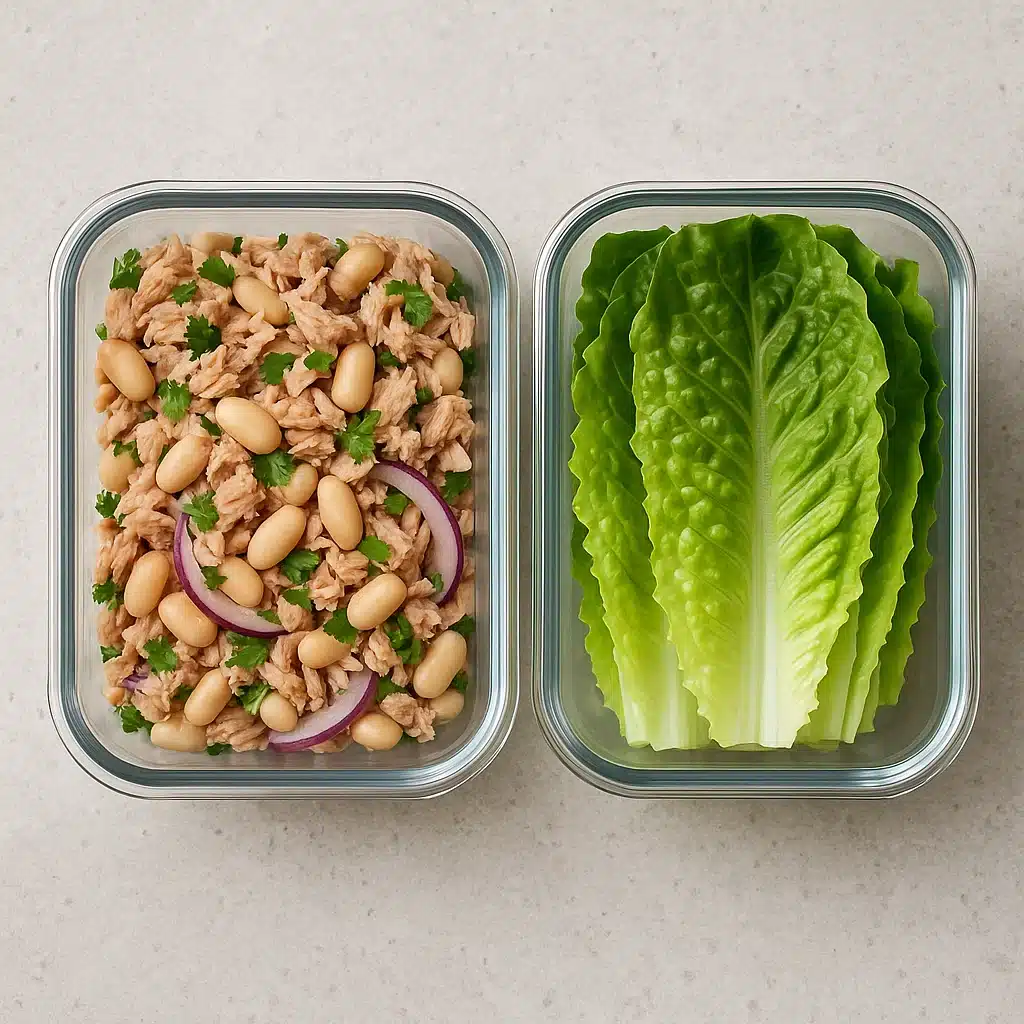
How to Meal Prep Tuna White Bean Salad Wraps
If you’re prepping for the week, here’s how to make sure your wraps stay fresh and flavorful:
- Store the salad and lettuce separately
Mix your tuna and white bean filling ahead of time and keep it refrigerated in an airtight container for up to 3–4 days. Wash and dry your lettuce leaves, then store them wrapped in paper towels inside a zip-top bag or container. - Assemble just before eating
To prevent sogginess, build your Tuna White Bean Salad Wraps right before serving or the morning of. This keeps the lettuce crisp and your meal satisfying. - Pack sauces separately
If you’re using yogurt or avocado-based sauces, store them in a small condiment container and drizzle just before eating. - Keep it chilled
Use an insulated lunch bag with an ice pack to keep everything cool and safe until you’re ready to eat.
Lettuce vs. Tortilla – Which Stores Better?
| Wrap Option | Storage Tips | Best Use Case |
|---|---|---|
| Bibb/Boston Lettuce | Store dry with paper towels in a sealed container | Best for low-carb and gluten-free meals |
| Whole Wheat Tortilla | Wrap filled and refrigerate for up to 2 days | Better for lunchboxes or kids’ meals |
Whether you’re wrapping in lettuce for a low-carb lunch or using a tortilla for a more filling option, these wraps are portable, customizable, and ideal for meal prepping.
Need another prep-ahead lunch idea? Try the Roasted Veggie Couscous Bowl—it holds up beautifully all week.
Mistakes to Avoid When Making Tuna Wraps
Even though Tuna White Bean Salad Wraps are simple and beginner-friendly, a few small mistakes can affect texture, taste, or nutrition. Here’s how to get it right every time.
1. Using Too Much Moisture in the Mix
Overmixing the tuna and beans—or using ingredients that are too wet—can lead to a soggy wrap. To prevent this:
- Drain tuna and beans thoroughly
- Pat lettuce leaves dry after rinsing
- Add avocado slices on top rather than mixing them in
A slightly chunky texture holds better and delivers the perfect bite in each wrap.
2. Overfilling Your Wraps
It’s tempting to stuff as much filling as possible, but doing so can make Tuna White Bean Salad Wraps hard to handle (especially with lettuce). Keep it simple:
- 2–3 tablespoons of filling per leaf is enough
- Fold or roll like a taco or lettuce burrito
- Use toothpicks to hold wraps together if needed for lunchboxes
3. Ignoring Seasoning Balance
Tuna and beans are mild ingredients. Without the right seasoning, your wraps can taste flat. Be sure to:
- Add enough salt and pepper
- Use acid (lemon juice or vinegar) to brighten flavors
- Toss in herbs like parsley, dill, or green onion for freshness
4. Assembling Too Early
If you’re making these ahead of time, store the filling and lettuce separately. Assembling too early leads to sogginess, especially if stored in the fridge overnight.
5. Not Adjusting for Personal Diet Goals
Whether you’re eating low-carb, watching sodium, or going dairy-free, Tuna White Bean Salad Wraps are easy to modify. For example:
- Use hummus instead of avocado for creaminess
- Add spicy mustard instead of creamy sauces
- Choose low-sodium tuna or rinse beans longer to reduce salt
These small changes help tailor the wraps to your goals—without sacrificing flavor.
Want more smart, easy-to-customize lunches? Don’t miss the Veggie and Hummus Wrap for a refreshing plant-based favorite.
Frequently Asked Questions (FAQ)
What should I put in a tuna wrap?
Start with tuna and white beans, then add chopped red onion, olive oil, fresh parsley, and avocado. For more flavor, add lemon juice, herbs, or a light yogurt sauce. Wrap it all in lettuce or a whole grain tortilla.
Are tuna wraps healthy to lose weight?
Yes, especially when made with clean ingredients like tuna, beans, and lettuce. They’re high in protein, low in carbs, and rich in fiber—perfect for weight loss or clean eating.
What sauce to put in a tuna wrap?
Try lemon-yogurt dressing, avocado-lime sauce, or mustard vinaigrette. Avoid mayo-based sauces for a lighter version unless using Greek yogurt as a substitute.
Is tuna and beans healthy?
Absolutely. This combo delivers lean protein, heart-healthy omega-3s, and gut-friendly fiber. Together, tuna and beans help with fullness, muscle repair, and blood sugar balance.
Conclusion
Tuna White Bean Salad Wraps aren’t just a healthy lunch—they’re a go-to solution for meal prep, clean eating, and satisfying flavor. They come together fast, are easy to customize, and support a wide range of wellness goals from weight loss to heart health.
Looking for more creative wraps? Try our Chickpea Salad Wrap Recipe—another fiber-filled, plant-powered option.
Let’s Keep the Inspiration Going!
If you loved this Tuna White Bean Salad Wraps recipe, there’s plenty more where that came from! Follow us on Facebook for daily recipe tips, behind-the-scenes kitchen moments, and healthy meal ideas the whole family will enjoy. And don’t forget to check out our Pinterest boards packed with visual meal plans, quick-prep lunches, and clean eating inspiration. Join our community and make healthy eating feel easy, fun, and delicious—every day of the week!
